|
1
|
Park in the Rectory Road car park and exit downhill via the passageway to the High Street. Turn right and walk along the High Street. Turn right (opposite The Railway Inn) up to the top end of Victoria Road and at the junction with Rectory Road you will see the factory of Joseph Knight on the corner to your left.
The former boot factory of Joseph Knight was here from 1893 until he moved to York Road in 1908. This factory was then taken over by F England Smith & Co, until 1930 when A W Head & Co, leather factors and merchants moved in.
|
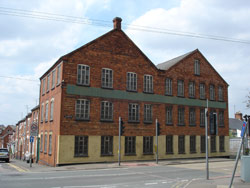 |
|
2
|
Turn left and after a short walk turn right into East Grove where the former factory of Messrs Phipps & Son (leather merchants & mercers) stands on your left.
Phipps & Son Ltd were established at Northampton in 1822. By 1898 they had opened a branch works at Rushden in West Street, where they made buckles, binding, buttons, lace and linings for boots and shoes. They also supplied leather and dressed leather, and in 1905 they moved into a new factory in East Grove.
|
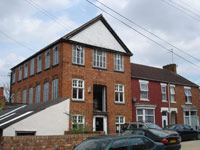 |
|
3
|
Turn back into Rectory Road and on the corner with Victoria Road is the former....
Boot & Shoe School, and the former Coxton Shoe Co, the latter being taken over by the Evening Telegraph works in the 1960s. The Coxton Shoe Co., was established in 1912, by Mr T W Cox and Mr C J Newton, on the Rock Estate in Rushden, and in 1914 they built this new factory in Rectory Road. Their early market was across the United Kingdom and the Empire: Australia, Canada, India, New Zealand, and South Africa.
|
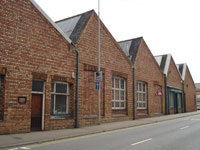 |
|
4
|
75 yards further along Rectory Road, on the corner of Albert Road, is the former factory of....
Ebenezer Claridge, later taken over by the Denton Brothers and recently in use by the Silver Reed Sewing Machines Company. (left in 2018)
Ebenezer Claridge began as a clicker, and established his own boot making company in 1876 in High Street, opposite "The Cottage". In the 1890s his sons joined him and they built this large new factory on the one-floor principle, in Rectory Road.
|
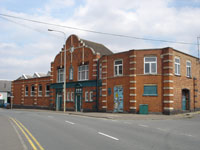 |
|
5
|
Further along Rectory Road turn left into Queen Street and travel 300 yards to the junction with ....
Cromwell Road where will see the imposing but no longer used facade of William Green & Sons (Grenson) Ltd. William Green and Sons has been making top quality welted footwear in the town for many generations. The trademark "Grenson" was first used in 1913, and it has been that leading brand name for 100 years. At one time the company employed over 400 highly skilled people, taking pride to make a pair of shoes to treasure for many years to come. Never a mass producer of footwear "Grenson" can proudly boast that the whole manufacturing journey through the factory from start to finish for a single pair of shoes could take up to three weeks to complete.
During the summer of 2013 they left their former home, where they had been based since 1895, and moved to the Crown Park estate in Rushden to a modern manufacturing complex.
|
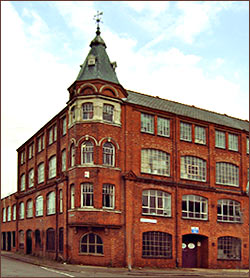 |
|
5a
|
Next door was H W Chapman Ltd, in Cromwell Road, a factory supplying all shoe factories with shoe boxes. This factory together with the former Grenson Factory have now been redeveloped as flats.
|
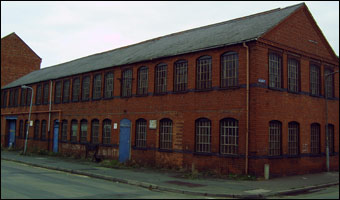 |
|
6
|
Walk a few paces along Cromwell Road and turn right into Portland Road.
A short way down on the left is the factory of Alfred Sargent & Sons. The company was founded in 1899, and today still remains a family business, with the fourth generation upholding the skills and craftsmanship required to produce the high quality Goodyear Welted footwear. They are committed to offering shoes of quality and styling to ensure that the name of Alfred Sargent is held in high regard by our customers worldwide.
|
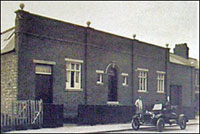 |
|
7
|
Carry on to the end of Portland Road to the junction with Rectory Road where ....
the former office block of the CWS Boot & Shoe Factory was built. The Office Block, pictured here, was built in 1920, and now with its listed facade it has now been converted into luxury flats.
The main factory which stood behind was demolished (see below) and replaced with housing in the 1980s.
|
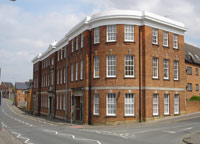 |
|
8
|
This branch of the above great Society was established in the year 1900, and is but one of a large number of Productive Factories belonging to the Co-operative Wholesale Society. It is one of the best equipped in the trade, with large air space and clean white bricks to line the interior.
The employees are working under very healthy and ideal conditions, and have every attention paid to their comfort and convenience. As in all branches of the C.W.S. they have the advantage of a Thrift Society and the Firm’s Bank and recently a clean and comfortable dining room has been opened to accommodate those who cannot get home to dinner. The production of the Society are men’s welted and machine-sewn in men’s and strong men’s, and of good medium class. They turn out some fine footwear, great regard being paid to their reliability. Throughout the trade the goods are recognised as being very superior both in style and wear, and few can cater better for their clientele than the Rushden branch of the C.W.S.
|
 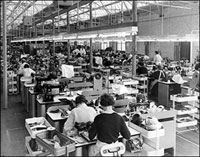 |
|
8a
|
The factory had its own team of Fire Fighters who won many competitions. In 1987 the Co-op boot & shoe factory was demolished to make way for the new flats development in Portland Road. The tower in the centre of the site had a huge tank on top of it which had fed the sprinkler system for the factory. This had a few surprises in store for the demolition men before its end. It took three attempts to pull it down as the cable used kept breaking.
(The photo shows the factory during the course of demolition)
|
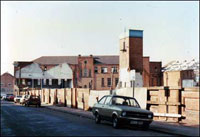 |
|
9
|
Proceed along Rectory Road to the traffic lights and turn right down the hill towards the pedestrian light crossing. Immediately opposite and across the road between the town council offices/library and the church vestry once stood ...
... the former Ashford & Campion's factory. In 1921 it became the main factory of John White Shoes, and was expanded several times. (Now replaced by Risdene Court apartments).
Newsclip 1930: "When standing anywhere in the big area of the making and finishing departments of the factory, the chief and most scientifically organised of the firm’s three factories – one is almost overwhelmed at the sight of multitudinous machine operations and the roar which they produce. Also one is struck with the fact that, enormous as is the output, there is nothing rushed or frantic in the movements of the operators. Scores of thousands of boots and shoes on racks fill most of the spaces between countless machines, and as there is no waste floor space the racks need to be moved only a few inches from one operator to another. Always having an eye to the health of the operatives, Mr. White has taken special pains over the clicking department. From such sections of boot factories in times past have come the worst records of tuberculosis in the industry. To obviate that in his own works, Mr. White has had the clickers’ department specially large, light and airy."
|
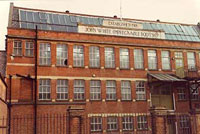 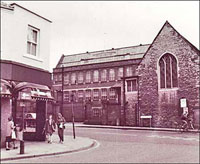
|
|
10
|
Walk on over the High Street and bear right into Church Street. Carry on down past The Salvation Army buldings. Cross over John Street and on the right is the Italian restaurant of 'Pizzeria Venezia'.
This building in 1920 became the first factory of John White.
(KB (Keep Believing) Autobiography by John White 1969...... "I was only about two years in this place, but I turned out 2,000 pairs a week. I engaged scores of employees, but there were also a lot of men making shoes outside. It was a long time before I had machinery to make the shoes. Things had got bad then; a slump was developing.
My little shop was only 30 yards from the labour exchange and there was a constant queue of men casting longing eyes at my busy throng of workers. I packed that shop so full of men that when the shoes were made I had to pack them outside in the street.
On the top floor I put clickers, on the middle floor sewers and stitchers, to stitch the soles. In one of the big rooms I had a team making shoes by hand. On the ground floor was the finishing plant. So it was a really compact little factory. I packed it so full that some of the workers trembled when buses went by as the vibration made the building sway."
John White continued to prosper and was employing 250 within a year and had works in Church Street (head office) and in Griffiths Street. These were followed by the acquisition of the Newton Road factory which he purchased including the machinery and he extended it three times by 1928. His skills in cutting had kept profitability high in the early days and his ability to calculate accurate costings put the company on steady footing.
|
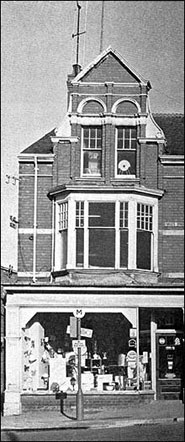 |
|
From here, walk back up, turn left into High Street, back up the passageway to your starting point at Rectory Road car park. |
Rushden Walks
|